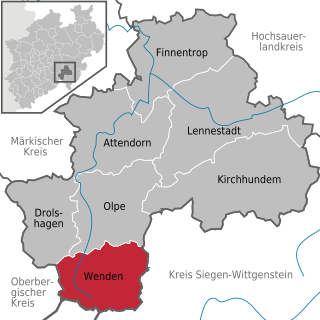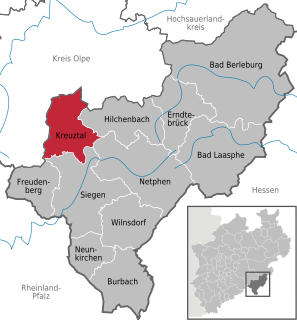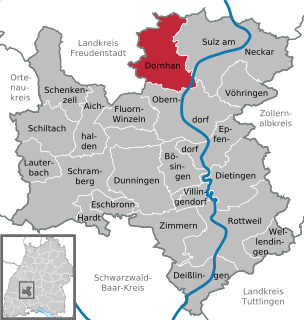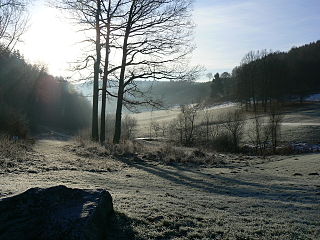
The London Borough of Waltham Forest is a London borough in north east London, England. Its population is estimated to be 276,983 in 2019.

Lake Forest is a city located in Lake County, Illinois, United States. As of the 2010 census it had a population of 19,375. The city is along the shore of Lake Michigan, and is a part of the Chicago metropolitan area and the North Shore. Lake Forest was founded with Lake Forest College and was laid out as a town in 1857, a stop for travelers making their way south to Chicago. The Lake Forest City Hall, designed by Charles Sumner Frost, was completed in 1898. It originally housed the fire department, the Lake Forest Library, and city offices.

Wenden is a community in North Rhine-Westphalia, Germany. It belongs to the Olpe district in the Sauerland. It lies 10 kilometres south of Olpe and 20 km (12 mi) northwest of Siegen.

Weiden an der March is a municipality in the district of Gänserndorf in Lower Austria, Austria.
Pilchuck Glass School is an international center for glass art education. The school was founded in 1971 by Dale Chihuly, Anne Gould Hauberg (1917-2016) and John H. Hauberg (1916-2002). The campus is located on a former tree farm in Stanwood, Washington, United States and the administrative offices are located in Seattle. The name "Pilchuck" comes from the local Native American language and translates to "red water", in reference to the Pilchuck River. Pilchuck offers one-, two- and three-week resident classes each summer in a broad spectrum of glass techniques as well as residencies for emerging and established artists working in all media.

Tuzi is a small town and seat of Tuzi Municipality, Montenegro. It is located along a main road between the city of Podgorica and the Albanian border crossing, just a few kilometers north of Lake Skadar. The Church of St. Anthony and Qazimbeg's Mosque are located in the centre of the town. Tuzi is the newest municipality in Montenegro, becoming an independent municipality since 1st September 2018.

Hilchenbach is a town in the Siegen-Wittgenstein Kreis (district) of North Rhine-Westphalia, Germany.

Kreuztal is a town in the Siegen-Wittgenstein district, in North Rhine-Westphalia, Germany.

Netphen is a town in the Siegen-Wittgenstein district, in North Rhine-Westphalia, Germany. It lies on the river Sieg, roughly 7 km northeast of Siegen.

Dornhan is a town in the district of Rottweil, in Baden-Württemberg, Germany. It is situated in the eastern Black Forest, 14 km southeast of Freudenstadt.

Kingsley is a civil parish and a village in the unitary authority of Cheshire West and Chester and the ceremonial county of Cheshire, England. It is approximately 5 miles south east of the town of Frodsham.

Floß is a municipality in the district of Neustadt an der Waldnaab in Bavaria, Germany.

Hottenbach is an Ortsgemeinde – a municipality belonging to a Verbandsgemeinde, a kind of collective municipality – in the Birkenfeld district in Rhineland-Palatinate, Germany. It belongs to the Verbandsgemeinde Herrstein-Rhaunen, whose seat is in Herrstein.
SpVgg SV Weiden, formerly just SpVgg Weiden, is a German association football club from the city of Weiden, Bavaria. Playing in the tier-four Regionalliga Süd in 2010–11, the club had to declare insolvency after being more than Euro 1 million in debt. Unable to raise enough funds to continue competing in the league, Weiden declared on 30 November 2010 that it would withdraw its Regionalliga team and thereby automatically be relegated. All games for the club in the 2010–11 season were declared void.

Hauberg is a type of communal forest management that is typical of the Siegerland and adjacent parts of the Lahn-Dill Uplands and the Westerwald in central Germany. Its aim is to manage the forest in order to produce tanbark and charcoal for the regionally important iron ore industry as well as firewood. In addition to forestry uses, the area also has agricultural uses, such as the growing of rye and buckwheat, typical of shifting cultivation, in the year after the timber harvest, as well as subsequent communal grazing (commons).

Junkernhees is a constituent community of Kreuztal, Siegen-Wittgenstein, North Rhine-Westphalia, Germany.

Mittelhees is a constituent community of Kreuztal, Siegen-Wittgenstein, North Rhine-Westphalia, Germany.

Osthelden is a constituent community of Kreuztal, Siegen-Wittgenstein, North Rhine-Westphalia, Germany and has its name from the stream Osthelde. It is located on the road from Wenden to Kreuztal, where the road descends into the valley with a sharp bend and has 710 inhabitants.

The Regensburg–Weiden railway is a two-track main line railway in Bavaria, Germany. It connects the Upper Palatinate district capital of Regensburg via Schwandorf with Weiden in der Oberpfalz.
The Kreuztal–Cölbe railway is a 88-kilometre-long main line in Hesse and North Rhine-Westphalia, Germany. It branches off the Ruhr–Sieg railway at Kreuztal and runs via Erndtebrück, Bad Laasphe and Biedenkopf to Cölbe. Operationally, the line is now divided into two parts. The Kreuztal–Erndtebrück section is operated together with the Erndtebrück–Bad Berleburg railway as the Rothaar-Bahn and the subsequent section to Cölbe, now operated by the Kurhessenbahn, is called the Obere Lahntalbahn. Trains at the eastern end of the line run to/from Marburg (Lahn).





















